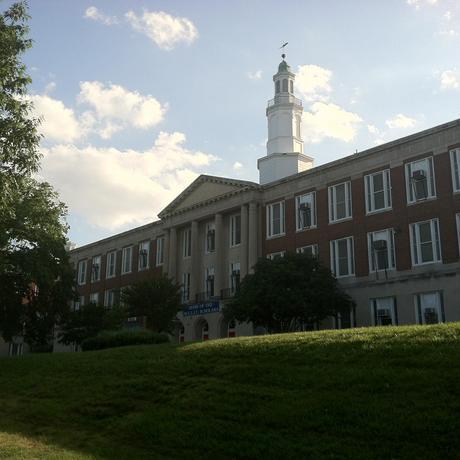Can Paul PCS and other charters thrive without private funds?
Paul Public Charter School has achieved excellent results with much less private money than other high-performing charter schools in DC. Can it serve as a model for other charters that don’t want to rely on philanthropy? Apparently not.
The DC Public Charter School Board (PCSB) has ranked Paul in the top tier of charter schools in DC. But compared to other top-ranked charters, the amount of private funding the school receives is astonishingly low. Over the past 3 years Paul, a middle school, has received an average of only $132 per student per year. Another top-ranked charter, KIPP DC, took in literally over 27 times that amount. The private contributions are in addition to public funding of about $9000 per student.
Paul has been able to keep its operating expenses low by being frugal, creative, and responsible with its funds, according to its CEO, Jami Dunham. But when it comes to things like building expenses, Paul faces the same funding problems as many other charters. The $3000-per-pupil facilities allotment from the DC government isn’t enough to cover its needs.
Started as a DCPS junior high
The school, which is located in the Brightwood neighborhood in Ward 4, started life in 1930 as a DCPS junior high school. In 2000, it became the first and only DCPS school to convert to a charter school, keeping its name, its building, and its firebrand of a principal, Cecile Middleton.
Although there was neighborhood opposition to the conversion, Paul PCS started out with certain advantages: it had an experienced leader who knew exactly what she wanted to accomplish, and it had ample physical space.
While the abundance of space has allowed for extracurricular offerings like football and dance, it’s also required a good deal of maintenance. Generally, the school looks great. But the athletic field and basketball court are far from pristine, and some parts of the massive building aren’t air-conditioned.
Dunham says that the school has spent $3.5 million on building renovations, which included installing student lockers and an elevator. The renovations were done more than 3 years ago, prior to the period included in the $132-per-student figure. But because that figure only reflects Paul’s operating budget and not its capital budget, the $3.5 million wouldn’t have been factored into it anyway.
Now Paul is embarking on another large capital project, the addition of a wing to accommodate its new high school. The money for that project will need to come from private sources.
This isn’t a problem limited to Paul. According to Friends of Choice in Urban Schools (FOCUS), a charter advocacy group, charter schools get significantly less public money per pupil than DCPS schools: $1700 less per student in operating funds and $7000 less in facilities funds. FOCUS has been making a perennial push for funding equity between DCPS and the charter sector, which it says is required under DC law.
DC is now at last beginning to lease some of the many mothballed former DCPS schools to charters, but often those buildings require substantial renovation, or even demolition, before the charters can make use of them. And charter schools don’t necessarily get a credit against their rent for capital improvements.
More focus on fundraising
Partly as a result of its decision to expand, Paul is now becoming more like other charters in focusing on raising funds. It has looked to an organization called Charter Board Partners to recruit board members with the skills and connections it needs to grow. Dunham has taken on more responsibility for fundraising in her role as school leader. And in June, the school brought on a full-time development director who is laying the groundwork for a $2 million capital campaign.
Even when it comes to operating expenses, it’s not clear how much longer Paul will be able to rely on its barebones budget. Dunham says that one area where she’s been able to economize in the past is teacher salaries. Unlike many other high-performing charters, Paul has a traditional rather than an extended day, so teachers work fewer hours and are paid less. Despite the low salaries, Dunham says teachers have generally stayed on because they value the instructional freedom and familial atmosphere they find at Paul.
But lately, she says, it’s “getting to be more difficult to hire and retain teachers” because of higher salaries elsewhere, including at DCPS. Generally, Paul has been frugal more by necessity than choice, and it’s a situation that the school is clearly working to change.
Paul is a school that seems both nurturing and challenging, with many features that other schools might want to emulate. While its test scores are high, with 61% of its students proficient in math reading and 81% in reading math, the school also ensures that kids have opportunities to engage in performing arts and athletics. Its school culture is structured but not overly rigid, and its high school will be the first in the area to be part of the Asia Society’s International School Studies Network. And unlike other top charters, Paul doesn’t have a waiting list. But it’s not quite the “miracle” charter school it at first appears, functioning almost entirely on public money.
When charter schools were young and scrappy and experimental, perhaps it made sense to have them reliant on private philanthropy. But does it still make sense at a time when almost half the kids in the DC public education system are in charters? What happens to those kids if that private funding goes away?
DCPS has just spent $122 million rebuilding Dunbar High School, which is half empty. Meanwhile, DC charter schools that have long waiting lists and do a better job of educating high-poverty students have to engage in massive fundraising to retain good teachers and keep their buildings in decent shape.
Something seems to be wrong with this picture.

